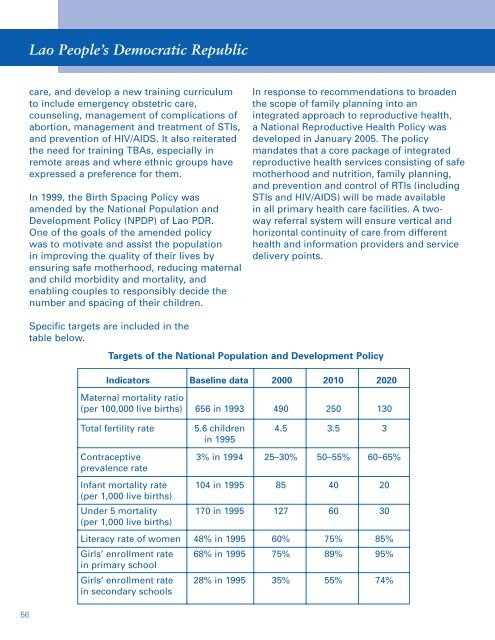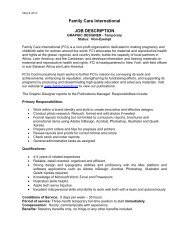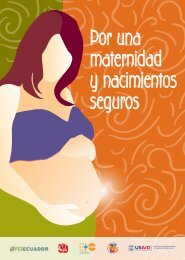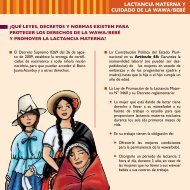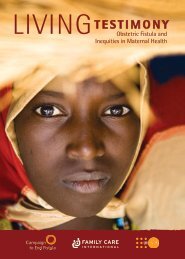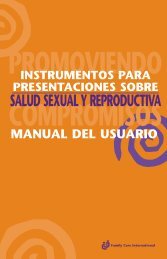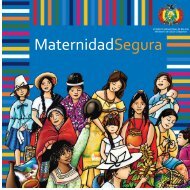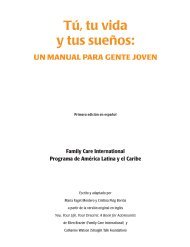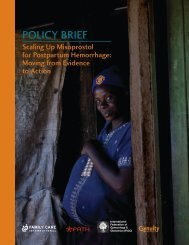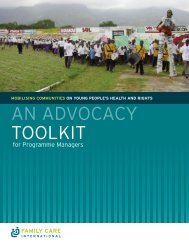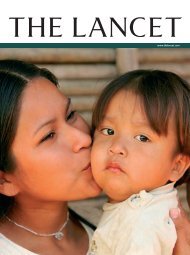Safe Motherhood: A Review - Family Care International
Safe Motherhood: A Review - Family Care International
Safe Motherhood: A Review - Family Care International
Create successful ePaper yourself
Turn your PDF publications into a flip-book with our unique Google optimized e-Paper software.
Lao People’s Democratic Republic<br />
care, and develop a new training curriculum<br />
to include emergency obstetric care,<br />
counseling, management of complications of<br />
abortion, management and treatment of STIs,<br />
and prevention of HIV/AIDS. It also reiterated<br />
the need for training TBAs, especially in<br />
remote areas and where ethnic groups have<br />
expressed a preference for them.<br />
In 1999, the Birth Spacing Policy was<br />
amended by the National Population and<br />
Development Policy (NPDP) of Lao PDR.<br />
One of the goals of the amended policy<br />
was to motivate and assist the population<br />
in improving the quality of their lives by<br />
ensuring safe motherhood, reducing maternal<br />
and child morbidity and mortality, and<br />
enabling couples to responsibly decide the<br />
number and spacing of their children.<br />
Specific targets are included in the<br />
table below.<br />
In response to recommendations to broaden<br />
the scope of family planning into an<br />
integrated approach to reproductive health,<br />
a National Reproductive Health Policy was<br />
developed in January 2005. The policy<br />
mandates that a core package of integrated<br />
reproductive health services consisting of safe<br />
motherhood and nutrition, family planning,<br />
and prevention and control of RTIs (including<br />
STIs and HIV/AIDS) will be made available<br />
in all primary health care facilities. A twoway<br />
referral system will ensure vertical and<br />
horizontal continuity of care from different<br />
health and information providers and service<br />
delivery points.<br />
Targets of the National Population and Development Policy<br />
Indicators Baseline data 2000 2010 2020<br />
Maternal mortality ratio<br />
(per 100,000 live births) 656 in 1993 490 250 130<br />
Total fertility rate 5.6 children<br />
in 1995<br />
Contraceptive<br />
prevalence rate<br />
Infant mortality rate<br />
(per 1,000 live births)<br />
Under 5 mortality<br />
(per 1,000 live births)<br />
Girls’ enrollment rate<br />
in primary school<br />
Girls’ enrollment rate<br />
in secondary schools<br />
4.5 3.5 3<br />
3% in 1994 25–30% 50–55% 60–65%<br />
104 in 1995 85 40 20<br />
170 in 1995 127 60 30<br />
Literacy rate of women 48% in 1995 60% 75% 85%<br />
68% in 1995 75% 89% 95%<br />
28% in 1995 35% 55% 74%


